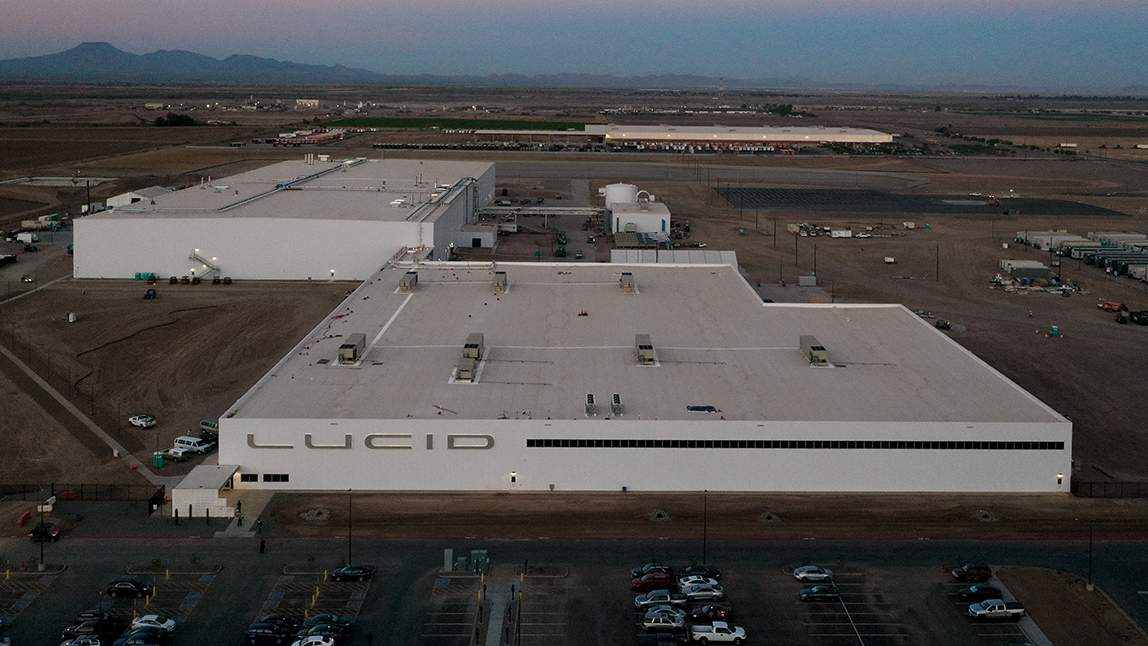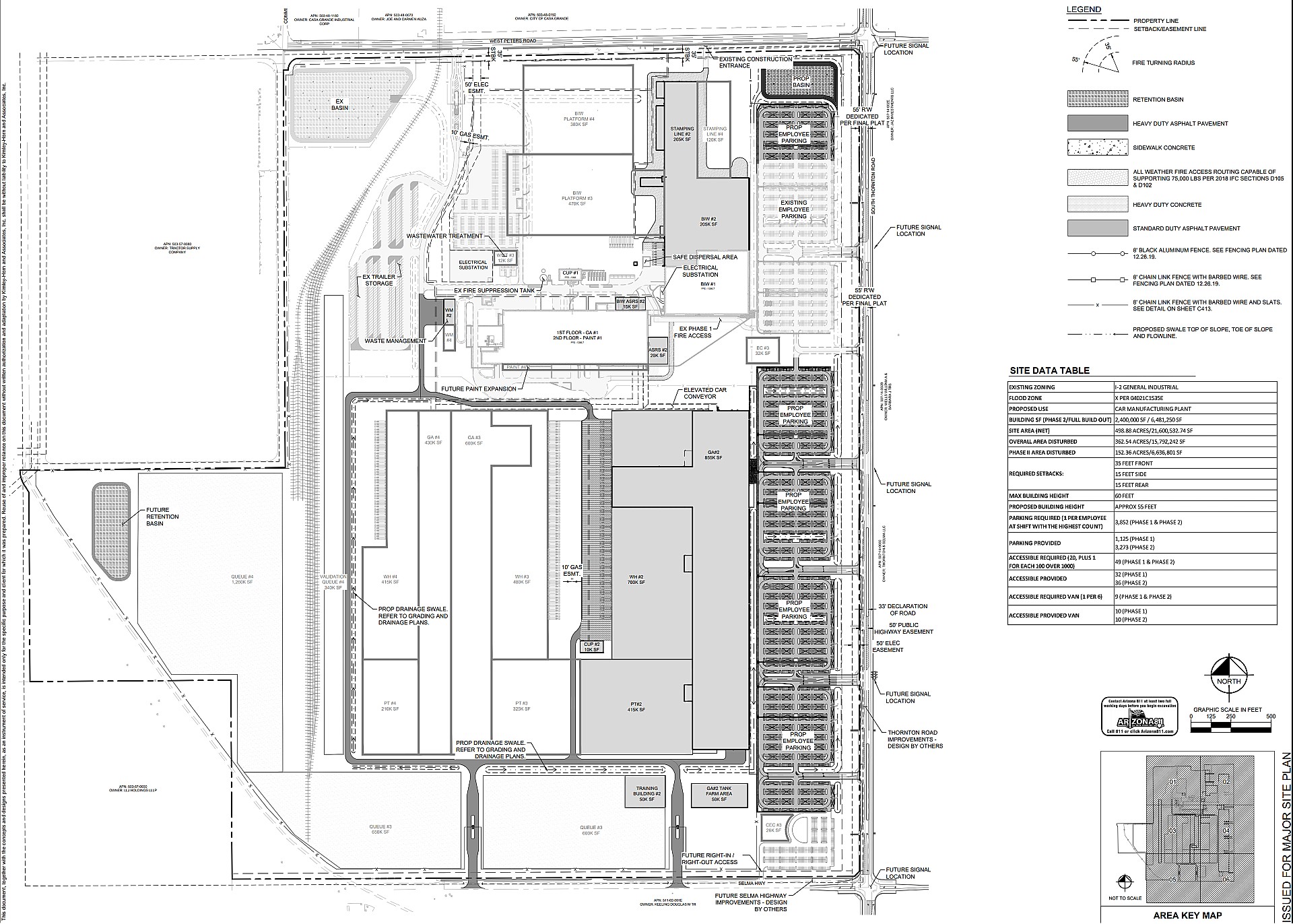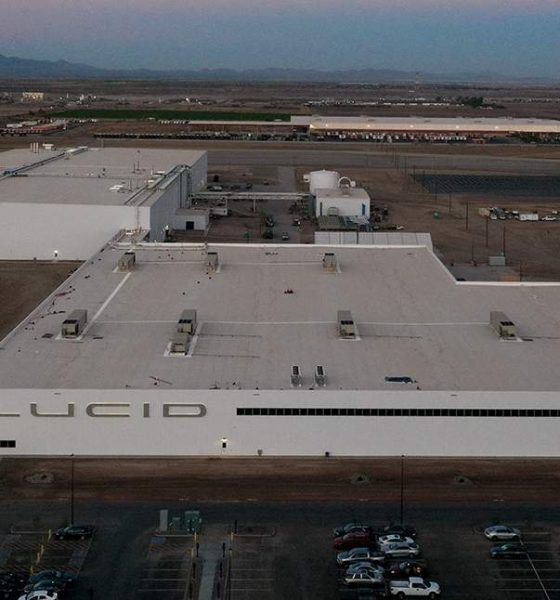Lucid Motors has received approval from the Casa Grande City Council to begin the construction of the Phase 2 portion of its new electric vehicle manufacturing facility.
Lucid, an electric vehicle company based out of Newark, California, has been preparing for the initial production phases of the Lucid Air, the company’s first production vehicle. The EV will be built at the company’s Casa Grande, Arizona factory, which has been under construction since December 2019. The first phase was completed on December 1st, 2020, and is capable of delivering up to 30,000 vehicles annually. However, the company has planned an expansion since before the initial groundbreaking took place several winters ago.
After applying for an expansion, known as Phase 2, Casa Grande’s City Council approved the project on March 4th, which will ultimately see an expansion of 2,400,000 square feet.
Lucid’s Casa Grande Factory (Credit: Lucid)
The application for the site describes the project in detail:
“Lucid Motors, Inc. is planning to develop Phase 2 of a car manufacturing facility within the city of Casa Grande at the Southwest corner of Peters Road and Thorton Road. The proposed development encompasses ±500 acres of land in a portion of Section 36, Township 6, Range 5E, relative to the Gila and Salt River Base Line and Meridian in the City of Casa Grande, Arizona. More specifically, the disturbed area of the parcel is bounded by Phase 1 of the developed site immediately to the north, and underdeveloped land to the East, South, and West. In Phase 2, Lucid Motors is proposing to construct an approximate 2,400,000 SF of mechanical/industrial building space and approximately 3,000 parking spaces on approximately 152.36 acres. This plan set is to provide direction on the Phase 2 construction activities.
According to documents obtained by Teslarati, the Phase 2 expansion will consist of the following facilities:
- Body in White Expansion
- Stamping Plant
- General Assembly
- Powertrain Plant
- General Warehousing
- Several Supporting and Auxiliary Structures
- Future phases will expand the existing buildings and add a Customer Experience Center

Kimley-Horn Planning and Design Engineering Consultants is listed as the acting Civil Engineer and Landscape Architect.
The project was approved conditionally on March 4th, 2021, with the Planning Commission requesting that Lucid perform the following revisions to the project before it will be allowed to break ground:
- Extend pedestrian sidewalks to connect to Thornton Road sidewalk.
- Provide additional landscape per table 17.36.060.
- Meet all fire review comments regarding fire flow.
- Provide Finalized Traffic Impact Analysis.
- Provide Geotechnical reports reflecting specific building locations for caissons and vertical load.
Lucid details that the Phase 2 portion of its facility should begin later this year, “enabling production of Project Gravity, our premier SUV.” Recently, Lucid announced that it would delay the production of the Air until the second half of this year, Bloomberg reported initially. With the new Phase 2 beginning construction later this year, it plans to have a manufacturing capacity that will be “up to 400,000 annually,” the company said.
Recently, it was announced that Lucid had reached a merger agreement with Churchill Capital, a Special Purpose Acquisition Company (SPAC) that will take the electric automaker public.
The details of Lucid’s Phase 2 buildout are available below.
Lucid Phase 2 Plans Approved by Joey Klender on Scribd

News
Tesla FSD fleet is nearing 7 billion total miles, including 2.5 billion city miles
As can be seen on Tesla’s official FSD webpage, vehicles equipped with the system have now navigated over 6.99 billion miles.

Tesla’s Full Self-Driving (Supervised) fleet is closing in on almost 7 billion total miles driven, as per data posted by the company on its official FSD webpage.
These figures hint at the massive scale of data fueling Tesla’s rapid FSD improvements, which have been quite notable as of late.
FSD mileage milestones
As can be seen on Tesla’s official FSD webpage, vehicles equipped with the system have now navigated over 6.99 billion miles. Tesla owner and avid FSD tester Whole Mars Catalog also shared a screenshot indicating that from the nearly 7 billion miles traveled by the FSD fleet, more than 2.5 billion miles were driven inside cities.
City miles are particularly valuable for complex urban scenarios like unprotected turns, pedestrian interactions, and traffic lights. This is also the difference-maker for FSD, as only complex solutions, such as Waymo’s self-driving taxis, operate similarly on inner-city streets. And even then, incidents such as the San Francisco blackouts have proven challenging for sensor-rich vehicles like Waymos.
Tesla’s data edge
Tesla has a number of advantages in the autonomous vehicle sector, one of which is the size of its fleet and the number of vehicles training FSD on real-world roads. Tesla’s nearly 7 billion FSD miles then allow the company to roll out updates that make its vehicles behave like they are being driven by experienced drivers, even if they are operating on their own.
So notable are Tesla’s improvements to FSD that NVIDIA Director of Robotics Jim Fan, after experiencing FSD v14, noted that the system is the first AI that passes what he described as a “Physical Turing Test.”
“Despite knowing exactly how robot learning works, I still find it magical watching the steering wheel turn by itself. First it feels surreal, next it becomes routine. Then, like the smartphone, taking it away actively hurts. This is how humanity gets rewired and glued to god-like technologies,” Fan wrote in a post on X.
News
Tesla starts showing how FSD will change lives in Europe
Local officials tested the system on narrow country roads and were impressed by FSD’s smooth, human-like driving, with some calling the service a game-changer for everyday life in areas that are far from urban centers.

Tesla has launched Europe’s first public shuttle service using Full Self-Driving (Supervised) in the rural Eifelkreis Bitburg-Prüm region of Germany, demonstrating how the technology can restore independence and mobility for people who struggle with limited transport options.
Local officials tested the system on narrow country roads and were impressed by FSD’s smooth, human-like driving, with some calling the service a game-changer for everyday life in areas that are far from urban centers.
Officials see real impact on rural residents
Arzfeld Mayor Johannes Kuhl and District Administrator Andreas Kruppert personally tested the Tesla shuttle service. This allowed them to see just how well FSD navigated winding lanes and rural roads confidently. Kruppert said, “Autonomous driving sounds like science fiction to many, but we simply see here that it works totally well in rural regions too.” Kuhl, for his part, also noted that FSD “feels like a very experienced driver.”
The pilot complements the area’s “Citizen Bus” program, which provides on-demand rides for elderly residents who can no longer drive themselves. Tesla Europe shared a video of a demonstration of the service, highlighting how FSD gives people their freedom back, even in places where public transport is not as prevalent.
What the Ministry for Economic Affairs and Transport says
Rhineland-Palatinate’s Minister Daniela Schmitt supported the project, praising the collaboration that made this “first of its kind in Europe” possible. As per the ministry, the rural rollout for the service shows FSD’s potential beyond major cities, and it delivers tangible benefits like grocery runs, doctor visits, and social connections for isolated residents.
“Reliable and flexible mobility is especially vital in rural areas. With the launch of a shuttle service using self-driving vehicles (FSD supervised) by Tesla in the Eifelkreis Bitburg-Prüm, an innovative pilot project is now getting underway that complements local community bus services. It is the first project of its kind in Europe.
“The result is a real gain for rural mobility: greater accessibility, more flexibility and tangible benefits for everyday life. A strong signal for innovation, cooperation and future-oriented mobility beyond urban centers,” the ministry wrote in a LinkedIn post.
News
Tesla China quietly posts Robotaxi-related job listing
Tesla China is currently seeking a Low Voltage Electrical Engineer to work on circuit board design for the company’s autonomous vehicles.

Tesla has posted a new job listing in Shanghai explicitly tied to its Robotaxi program, fueling speculation that the company is preparing to launch its dedicated autonomous ride-hailing service in China.
As noted in the listing, Tesla China is currently seeking a Low Voltage Electrical Engineer to work on circuit board design for the company’s autonomous vehicles.
Robotaxi-specific role
The listing, which was shared on social media platform X by industry watcher @tslaming, suggested that Tesla China is looking to fill the role urgently. The job listing itself specifically mentions that the person hired for the role will be working on the Low Voltage Hardware team, which would design the circuit boards that would serve as the nervous system of the Robotaxi.
Key tasks for the role, as indicated in the job listing, include collaboration with PCB layout, firmware, mechanical, program management, and validation teams, among other responsibilities. The role is based in Shanghai.
China Robotaxi launch
China represents a massive potential market for robotaxis, with its dense urban centers and supportive policies in select cities. Tesla has limited permission to roll out FSD in the country, though despite this, its vehicles have been hailed as among the best in the market when it comes to autonomous features. So far, at least, it appears that China supports Tesla’s FSD and Robotaxi rollout.
This was hinted at in November, when Tesla brought the Cybercab to the 8th China International Import Expo (CIIE) in Shanghai, marking the first time that the autonomous two-seater was brought to the Asia-Pacific region. The vehicle, despite not having a release date in China, received a significant amount of interest among the event’s attendees.









